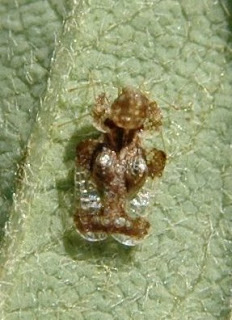Aphids are feeding and reproducing on many plants at this time of the year. The picture is of aphids feeding on tulip popular. Honeydew falling onto furniture, structures, vehicles, other plants and walkways can be a nuisance issue. These usually require no control efforts.
Some bagworm eggs have hatched and larvae have ballooned to nearby hosts. Look closely for the ‘dunce cap’ stage of these caterpillars feeding on trees and shrubs. Applications of Bt now through late June will provide excellent control of these small caterpillars.
Pine spittle bug requires no control efforts. They are just unsightly.
Roseslug sawflies are feeding on roses at this time. Early instars cause ‘window paning’ damage to leaves. Eventually the remaining dermal tissue of the leaf dries out and falls off the leaf leaving behind a smooth-edged hole in the leaf.
Sweet Mockorgange is in bloom to full bloom in Sussex county. As the sign indicates (from the education gardens) the arborvitae leafminer adult is flying and tussock moth caterpillars are feeding.
All pictures provided by Tracy Wooten, University of Delaware













